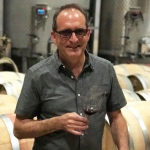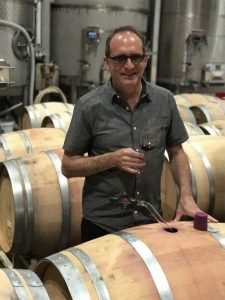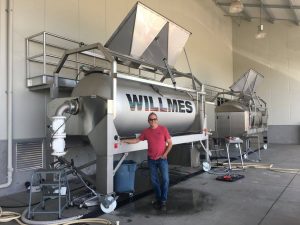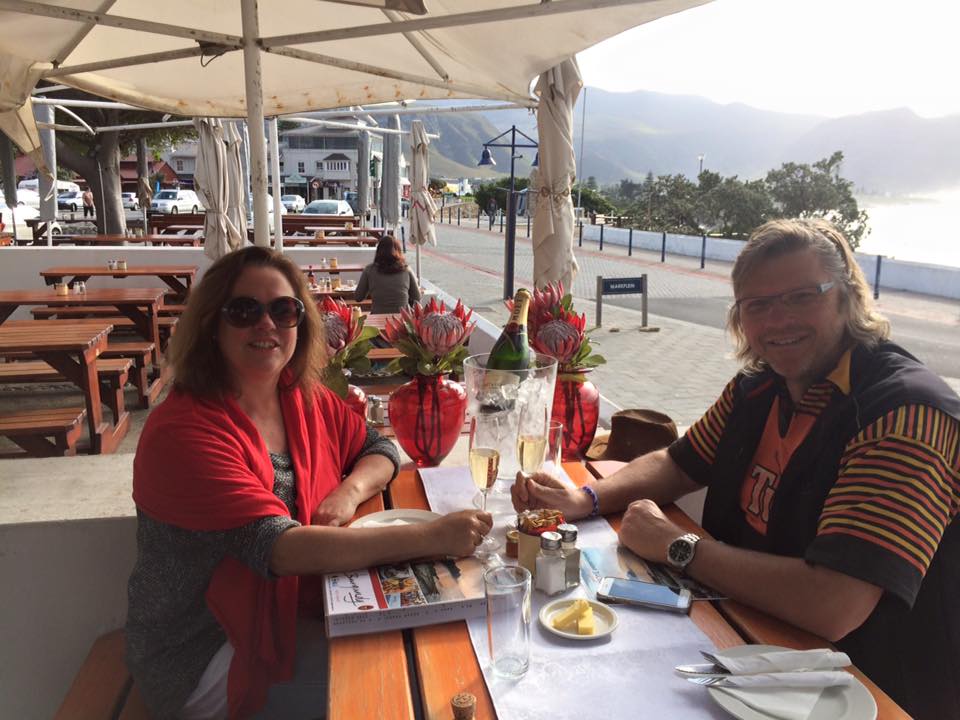

The Cunat Family are involved in all facets of winemaking, from planting the vineyards, selecting final blends before bottling to designing the labels and packaging. Two consulting winemakers, Bruce Regalia and Michael Trujillo provide expertise and oversee the process, ensuring the wines are made to the Cunat Family’s exacting standards. The family also ensures the guest experience is warm, welcoming and hospitable. With Neena’s background in luxury hotels (and Brian and Miki’s continued enjoyment in touring other wineries), they have created a core team that is nothing short of exceptional.

Bruce showing off a new press.
Bill – (Neena) What was the lure for your dad Brian to purchase land and start a vineyard in Napa over other places like Sonoma or Paso Robles?
We only had the interest to purchase a vineyard and produce wine in an area that consistently is able to produce the highest quality. Due to the unique climate, soils, and consistency, Napa Valley has proven to be the best place in the United States
Bill – When drinking wine, do you gravitate towards a white, red or certain style? With that said, is there a region in the world you prefer?
I like to drink lots of different of wine. The things I look for in a wine are varietal correctness if advertised as a particular varietal. Texture is very important to me. Wines that I enjoy hit every part of my tongue and have a long finish. For me, the nose should draw me in and the wine should evolve in the glass over time. If I had to pick one region I enjoy the wines of Burgundy.
Bill – What was the major reason why you started making?
The reason I started making wine was that a client I was planting a vineyard for fired his winemaker and talked me into doing it. I had been home winemaking and brewing but I had an incredibly steep learning curve.
Bill – What is the average age of the Materra vines?
The first vines were planted in 2008.
Bill – What are your vineyard farming methods?
Farming is different every year because it is completely weather dependent. This year because we started out with a lot of water in the soil profile the vines were very vegetative. As a result, we had to spend a lot of time on canopy management. No two years are the same. The trick is to spend a lot of time in the vineyard and adapt your farming to the season.
Bill – Do you use native or commercial yeast?
I usually use commercial yeast strains but occasionally will let things go native. Sometimes they just do!
Bill – We tasted some really great 2016 barrel samples from Lake County. Do you feel the quality of the fruit is just as good or not better than Napa?
I might get myself in trouble for saying this but I think there are many appellations that have just as good fruit as Napa at lower pricing. Napa has done a phenomenal job of marketing itself and as a result, has gained recognition as one of the premier growing areas in the world. It takes a tremendous amount of work and time to figure out rootstocks, clones, and varieties that perform well in a certain area. Napa has put in the work.
Bill – Do you have a signature wine?
I don’t know if it is a signature but I really enjoy the Materra Sauvignon Blanc, Viognier, and Chardonnay. The estate is as perfect as a spot as you can find to grow those varietals.
Bill – When you are not working in the winery or vineyard what are your interests?
When I am not working I like to cook, kayak, hike, and travel. I have a great yellow lab who is a great companion that I spend every day with. He has a great life.
Bill – Do you have any advice for someone who thinks he or she might want to work with wine?
Do a harvest or two under different winemakers and don’t get hemmed in by book learning. Winemaking is an exercise in paying attention. Some of the winemakers I respect the most had no formal training.
The day we met Bruce we tried the following wines and tasted some barrel samples too.
2016 Sauvignon Blanc (no wood or Malo Lactic Fermentation) – New release
2016 Viognier (no wood or Malo Lactic Fermentation)
2015 Chardonnay (very little Malo Lactic Fermentation)
2010 Oak Knoll Merlot
2012 Right Bank (100% Merlot)
2012 Cabernet Sauvignon Hidden Block (St Helena) – The owner named it Hidden Block as could not locate the vineyard.
2007 Cabernet Sauvignon
Barrel Samples: All were great and easy drinking now.
2016 Diamond Mountain Cabernet Sauvignon
2016 Diamond Mountain Cabernet Sauvignon Hidden Block
2016 Lake County Cabernet Sauvignon
2016 Merlot
2016 Estate Malbec
The Materra winery is relatively new to Napa Valley. The property was purchased in 2007 by the Cunat Family. The winery is located in the Oak Knoll AVA (between the town of Napa and Stags Leap on Big Ranch Road. Besides making their own wine, the facility is a custom crush that has 20 crush clients. 2015 was the first year the winery produced wine.
The Cunat family owns 50 acres of land. 40 acres is currently planted.
The barrel room can hold 5000 barrels. It has a separate room to conduct Malo lactic fermentation. Why do you need to warm up the room to allow the malo lactic bacteria (MLB) to work? A normal barrel room is held around 58 degrees. MLB needs to be in the upper 60’s to lower 70’s to convert malic acid to lactic acid.
If you want to learn more about Materra wines. Go to their website Materra Wines
I also have posted additional pictures on my Facebook page here.
Life is too short to drink crappy wine. Expand your palate and keep trying.
![]() Facebook.com/BillsWineWandering
Facebook.com/BillsWineWandering
![]() @BillsWineWander
@BillsWineWander


